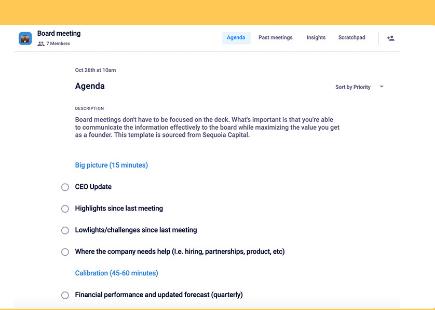How Do You Structure a Corporate Board Meeting Agenda?
A well-structured corporate board meeting agenda is critical to the efficiency and success of any organization’s governing body. It ensures that board members have a clear roadmap to guide their discussions and decisions. Here's how to organize an agenda that maximizes the productivity of your board meeting.

Start With a Clear Objective
Every item on your agenda should serve a clear purpose. Before the meeting, define what you aim to achieve — be it making strategic decisions, overseeing financial health, or evaluating management performance. This clarity helps to structure the agenda around concrete goals, enhancing the focus and efficiency of the meeting.
Designate Time for Review and Approval of Minutes
Begin the meeting with a review and approval of the minutes from the previous meeting. This process not only provides a recap of prior discussions and decisions but also ensures that all members are on the same page. Typically, allocating 10 to 15 minutes is sufficient for this task, depending on the extent of the previous meeting’s content.
Include a Strategic Update Section
Provide a high-level update on the company’s strategy and performance. This section should include key performance indicators (KPIs) and metrics that reflect the organization's current status against its strategic goals. A 20 to 30-minute presentation followed by a 10-minute discussion ensures that board members remain informed about the company’s trajectory and challenges.
Set Aside Time for Financial Reporting
Financial oversight is a core responsibility of the board. Schedule a detailed review of financial statements and reports, including profit and loss statements, balance sheets, and cash flow statements. A 30-minute segment allows sufficient time for the CFO or a financial expert to present these documents and answer any questions from the board.
Discuss Specific Business Items
Address specific business items that require board attention or approval. These can include major projects, legal issues, risk management, or corporate governance matters. Itemize each topic clearly with a brief description and allocate 15 to 20 minutes per item depending on complexity. This section should be flexible enough to accommodate in-depth discussion if needed.
Plan for Executive Sessions
Include an executive session without the CEO or other management team members. This part of the meeting, typically lasting 20 to 30 minutes, allows the board to discuss sensitive issues such as CEO performance, succession planning, or internal conflicts. It's a vital component for maintaining board independence and confidentiality.
Schedule Time for Open Discussion
Reserve time for any new business or open discussion. This segment allows board members to bring up issues not previously included in the agenda or elaborate on earlier discussions. Allocating 15 minutes to this section can help capture any spontaneous topics or critical concerns that arise during the meeting.
Always conclude with a recap of decisions and assignments. This final 10-minute wrap-up ensures that all members understand their responsibilities and the actions needed following the meeting.
By carefully structuring your corporate board meeting agenda, you enable your board to operate with strategic focus and effective governance. This organization not only supports thorough preparation but also drives constructive and decisive meetings that are essential for successful corporate oversight.
